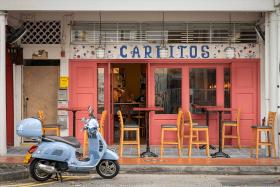Makansutra: Nasi ambeng done just right
Mr Desmond Theo was so taken with the dish, he set up a hawker stall to sell it
I had always wondered about the origins of nasi ambeng.
You'd think it was Indonesian, but fellow food critic William Wongso, the "godfather" of culinary culture in Indonesia, has never heard of it.
The dish - a decadent rice platter adorned with a sea of spicy rempah-based ingredients like rendang, fish, eggs, sayur lodeh, eggplant and even a salted egg - is offered by many nasi padang stalls.
The dish is also similar to Java's nasi tumpeng.
Thanks to Madam Aziza Ali, local pioneer of Malay cuisine and culture, I got to know what nasi ambeng is.
JAVANESE
"It is a meal eaten by old Javanese families, but I know of no one else that sold it commercially before I did in 1979," said Madam Aziza.
Her award-winning restaurant, Aziza's, used to be the fine-dining restaurant for Malay food in Singapore. It closed in 1998 due to the Asian financial crisis.
Mr Desmond Theo was so taken with the dish that he set up Enak two years ago, selling nasi ambeng at his hawker stall in the Bedok South Market and Food Centre.
He had learnt to cook the dish by watching others and experimenting.
-
Enak
-
Bedok South Market and Food Centre, Block 16, Bedok South Road, #01-04
-
7am-2pm, closed on Tuesdays and public holidays
Opening hours for the fasting month: 12pm to 6pm; same days off)
Priced at $6.50 for a single portion, $17 for two with extra meats, and $34 for four to five hungry foodies, each mound of rice is topped with fried shallots - always a winning visual for me - and a bowl of korma.
The rendang was savoury, rich, coconutty, and spicy, with some hints of sweetness and tenderness.
The chicken korma or "white curry" chicken was lemak (creamy) enough from the coconut milk.
I liked the sambal sotong or the cured sambal cuttlefish, which was extra soft.
The acar nanas - spicy and sour vegetable pickles with pineapples - helped cut the intensity. The salted egg was refreshing, as that bit of saltiness was agreeable with all that heat and spiciness.
The crunch came from the urap (spicy grated coconut and bean sprouts salad).
It seemed almost raw, which is how it should be, and the sweetness was a blessing.
The softness of the sambal terung (eggplant) was a nice reprieve from all the other textures, as was the begedil (potato patty), which was the only other non-spicy item on the platter.
The sambal goreng (sambal tofu and string beans) was the humble touch the meal needed and it did just that.
Get The New Paper on your phone with the free TNP app. Download from the Apple App Store or Google Play Store now




